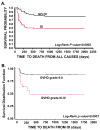Immune reconstitution after unrelated cord blood transplantation
- PMID: 17453963
- PMCID: PMC2203410
- DOI: 10.1080/14653240701231014
Immune reconstitution after unrelated cord blood transplantation
Abstract
Over the past years unrelated cord blood transplant (UCBT) has emerged as an effective alternative to unrelated donor blood and marrow transplantation. However, despite several advantages, its success is limited by the high incidence of opportunistic infections (OI), most of which are viral. Infection-related mortality is the primary cause of death after UCBT with most deaths occurring in the first 3-6 months post transplant. For several months, until recovery of the thymus is restored to support de novo T cell generation, protective antiviral immunity depends on the activity of post-thymic T cells infused within the cord blood (CB) grafts. However, almost all CB T cells are antigen inexperienced (naïve) lymphocytes that have been functionally altered by placental factors to protect pregnancy. CB T cells need to undergo in vivo priming, Th1/Tc1 maturation, and peripheral expansion before they can afford immunologic protection. This article provides an overview of what is currently known regarding the reconstitution of adaptive immunity following UCBT including our own data from prospective analyses of pediatric cohorts. Remarkable immunophenotypic changes are notable already in the first 2-3 weeks post-UCBT. These changes result from apparent 'homeostatic' peripheral T cell expansion in the lymphopenic environment. While we can identify patient- and graft-specific predictive factors, the concordant emergence of T cell subsets displaying the phenotype of Th1/Tc1 cytotoxic effector cells can be statistically linked to those UCBT recipients who will subsequently develop viral and other opportunistic infections. Antigen presenting dendritic cell reconstitution may also reflect alterations in immunocompetence due to OI and/or GVHD.
Figures


References
-
- Gluckman E, Broxmeyer HA, Auerbach AD, Friedman HS, Douglas GW, Devergie A, Esperou H, Thierry D, Socie G, Lehn P, et al. Hematopoietic reconstitution in a patient with Fanconi's anemia by means of umbilical-cord blood from an HLA-identical sibling. N Engl J Med. 1989;321:1174. - PubMed
-
- Kurtzberg J, Graham M, Casey J, Olson J, Stevens CE, Rubinstein P. The use of umbilical cord blood in mismatched related and unrelated hemopoietic stem cell transplantation. Blood Cells. 1994;20:275. - PubMed
-
- Rocha V, Gluckman E. Clinical use of umbilical cord blood hematopoietic stem cells. Biol Blood Marrow Transplant. 2006;12:34. - PubMed
-
- Barker JN, Davies SM, DeFor T, Ramsay NK, Weisdorf DJ, Wagner JE. Survival after transplantation of unrelated donor umbilical cord blood is comparable to that of human leukocyte antigen-matched unrelated donor bone marrow: results of a matched-pair analysis. Blood. 2001;97:2957. - PubMed
-
- Rocha V, Cornish J, Sievers EL, Filipovich A, Locatelli F, Peters C, Remberger M, Michel G, Arcese W, Dallorso S, Tiedemann K, Busca A, Chan KW, Kato S, Ortega J, Vowels M, Zander A, Souillet G, Oakill A, Woolfrey A, Pay AL, Green A, Garnier F, Ionescu I, Wernet P, Sirchia G, Rubinstein P, Chevret S, Gluckman E. Comparison of outcomes of unrelated bone marrow and umbilical cord blood transplants in children with acute leukemia. Blood. 2001;97:2962. - PubMed
Publication types
MeSH terms
Grants and funding
LinkOut - more resources
Full Text Sources
Other Literature Sources
Miscellaneous

